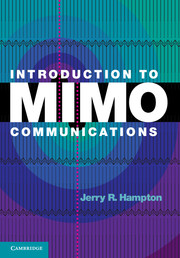Book contents
- Frontmatter
- Contents
- Preface
- 1 Overview of MIMO communications
- 2 The MIMO capacity formula
- 3 Applications of the MIMO capacity formula
- 4 RF propagation
- 5 MIMO channel models
- 6 Alamouti coding
- 7 Space-time coding
- 8 Spatial multiplexing
- 9 Broadband MIMO
- 10 Channel estimation
- 11 Practical MIMO examples
- Appendices
- References
- Index
6 - Alamouti coding
Published online by Cambridge University Press: 05 December 2013
- Frontmatter
- Contents
- Preface
- 1 Overview of MIMO communications
- 2 The MIMO capacity formula
- 3 Applications of the MIMO capacity formula
- 4 RF propagation
- 5 MIMO channel models
- 6 Alamouti coding
- 7 Space-time coding
- 8 Spatial multiplexing
- 9 Broadband MIMO
- 10 Channel estimation
- 11 Practical MIMO examples
- Appendices
- References
- Index
Summary
This chapter describes the Alamouti space-time coding scheme [6] for achieving transmit diversity. As discussed in Chapter 1, Alamouti coding was one of the first space-time codes to be developed, and it is now included in the definition of all modern wireless standards that employ MIMO techniques. Although other transmit diversity techniques were proposed in the 1990s prior to Alamouti's seminal paper (e.g. see [81], [82], and [79]), Alamouti's technique has the following advantages over alternative schemes: a) it requires CSIR only (as opposed to requiring both CSIT and CSIR); b) it does not involve any bandwidth expansion, which some of the competing techniques do; and c) Alamouti coding has relatively low computational complexity due to the fact that its decoding rules are quite simple.
Prior to the development of transmit diversity techniques in the 1990s, of which Alamouti coding is the most famous example, diversity benefits in fading environments were achieved using receive diversity only. In cellular applications, this meant that it was only possible to perform diversity combining at the base station because of the impracticality (due to lack of physical space and battery power limitations) of having multiple antennas on small hand-held devices. Therefore, prior to the development of space-time coding, which made transmit diversity possible, diversity gains were only available on the reverse links of cellular systems.
- Type
- Chapter
- Information
- Introduction to MIMO Communications , pp. 114 - 130Publisher: Cambridge University PressPrint publication year: 2013
- 1
- Cited by



